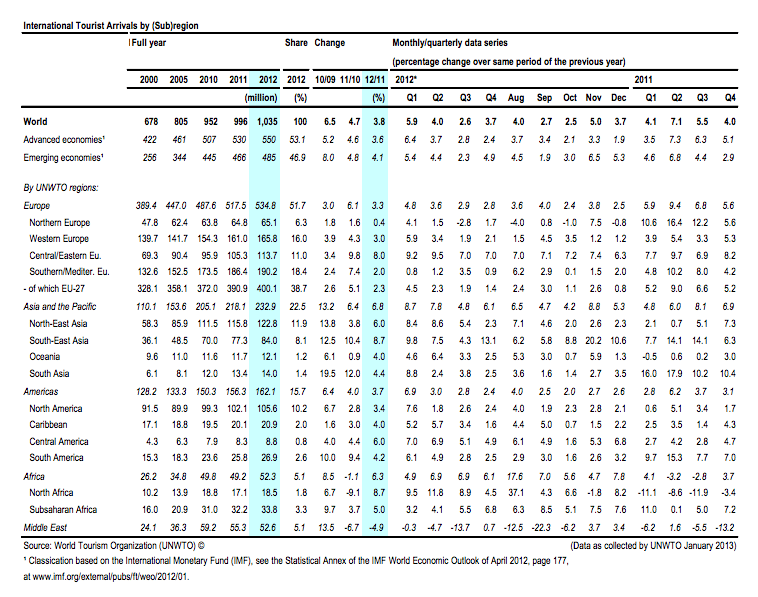Skift Take
Large parts of the world were in turmoil in 2012, and yet the travel numbers keep growing amidst increasing globalization, trade, and travel from parts of the world that weren't used to so much not so long ago. The global locus of travel is moving away from the western hemisphere, that much is certain.
The much awaited global tourism numbers are here, and we have now entered the era of the billion plus for the first time in history. The global traveler community crossed the one billion mark in 2012, and today the United Nations World Tourism Organization released the official figures: 1.035 billion tourists crossed international borders last year.
Topline numbers:
- International tourist arrivals grew by 4% in 2012 to reach 1.035 billion.
- Additional 39 million international tourists arrived in 2012, up from 996 million in 2011,
- Emerging economies (+4.1%) regained the lead over advanced economies (+3.6%), with Asia and the Pacific showing the strongest results.
- By region, prospects for 2013 are stronger for Asia and the Pacific (+5% to +6%), followed by Africa (+4% to +6%), the Americas (+3% to +4%), Europe (+2% to +3%) and the Middle East (0% to +5%).
- Growth in 2013 is expected to continue only slightly below the 2012 level (+3% to +4%), much in line with its long term forecast for 2030: +3.8% a year on average between 2010 and 2020.
Geographic numbers:
- Europe: International tourist arrivals to Europe, the most visited region in the world, were up by 3%; a very positive result in view of the economic situation, and following a strong 2011 (+6%). Total arrivals reached 535 million, 17 million more than in 2011. By sub-region, Central and Eastern Europe destinations (+8%) experienced the best results, followed by Western Europe (+3%). Destinations in Southern Mediterranean Europe (+2%) consolidated their good performance of 2011 and returned in 2012 to their normal growth rates.
- Asia and the Pacific: Region (+7%) was up by 15 million arrivals in 2012, reaching a total 233 million international tourists. South-East Asia (+9%) was the best performing sub-region much due to better policies. Growth was also strong in North-East Asia (+6%), as Japanese inbound and outbound tourism recovered, while it was comparatively weaker in South Asia (+4%) and in Oceania (+4%).
- Americas: It (+4%) saw an increase of 6 million arrivals, reaching 162 million in total. Leading the growth were destinations in Central America (+6%), while South America, up by 4%, showed some slowdown as compared to the double-digit growth of 2010 and 2011. The Caribbean (+4%), on the other hand, is performing above the previous two years, while North America (+3%) consolidated its 2011 growth.
- Africa: It (+6%) recovered well from its setback in 2011 when arrivals declined by 1% due largely to the negative results of North Africa due to Arab spring. Arrivals reached a new record (52 million) (+9% as compared to a 9% decline in 2011) and to the continued growth of Sub-Saharan destinations (+5%). Results in the Middle East (-5%) improved after a 7% decline in 2011, yet the region recorded an estimated 3 million international tourist arrivals less in 2012 in spite of the clear recovery in Egypt.
Top destinations: Among the top ten tourist destinations, receipts were up significantly in Hong Kong (China) (+16%), the USA (+10%), the UK (+6%) and Germany (+5%). At the same time, a significant number of destinations around the world saw receipts from international tourism increase by 15% or more – Japan (+37%), India and South Africa (both +22%), Sweden and the Republic of Korea (both +19%), Thailand (+18%) and Poland (+16%).
Money spend by countries: How the world has changed on that. The highest growth rates in expenditure abroad among the ten top markets came from emerging economies – China (+42%) and Russia (+31%). In Europe despite economic pressures, expenditure on international tourism by Germany held well at +3%, while the UK (+5%) returned to growth after two flat years. In the Americas, both the USA and Canada grew at 7%. On the other hand, France (-7%) and Italy (-2%) registered declines in travel expenditure.
Total tourism numbers by region, chart below:
The full press conference video from UNWTO, embedded below (Warning: horrible quality, mix of Spanish and English so confusing. UNWTO, get your PR and media act together!)
The Daily Newsletter
Our daily coverage of the global travel industry. Written by editors and analysts from across Skift’s brands.
Have a confidential tip for Skift? Get in touch

